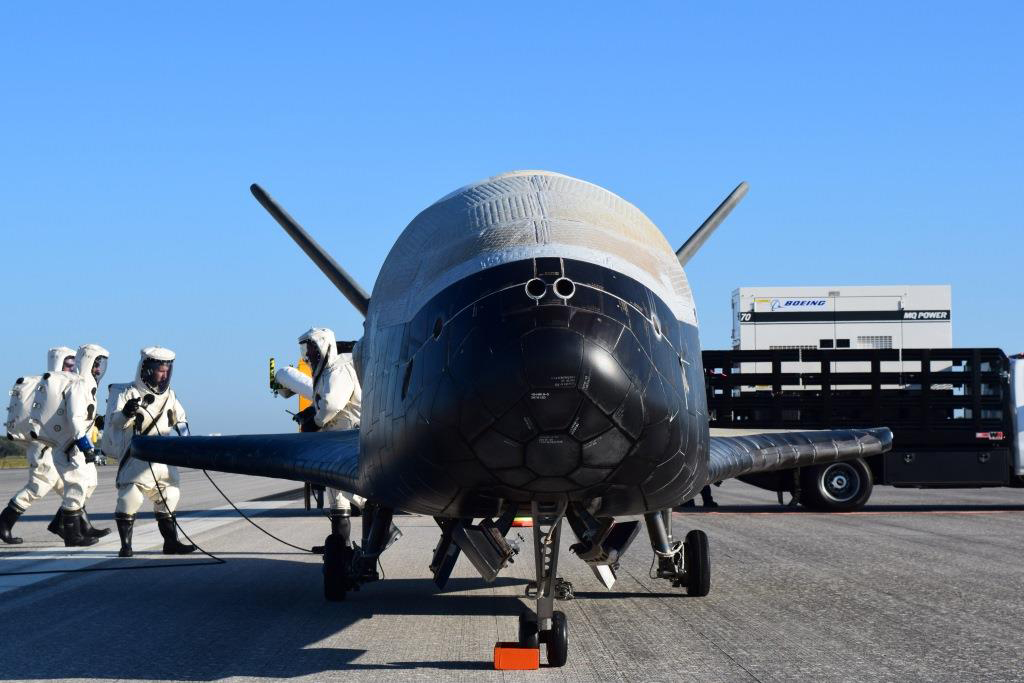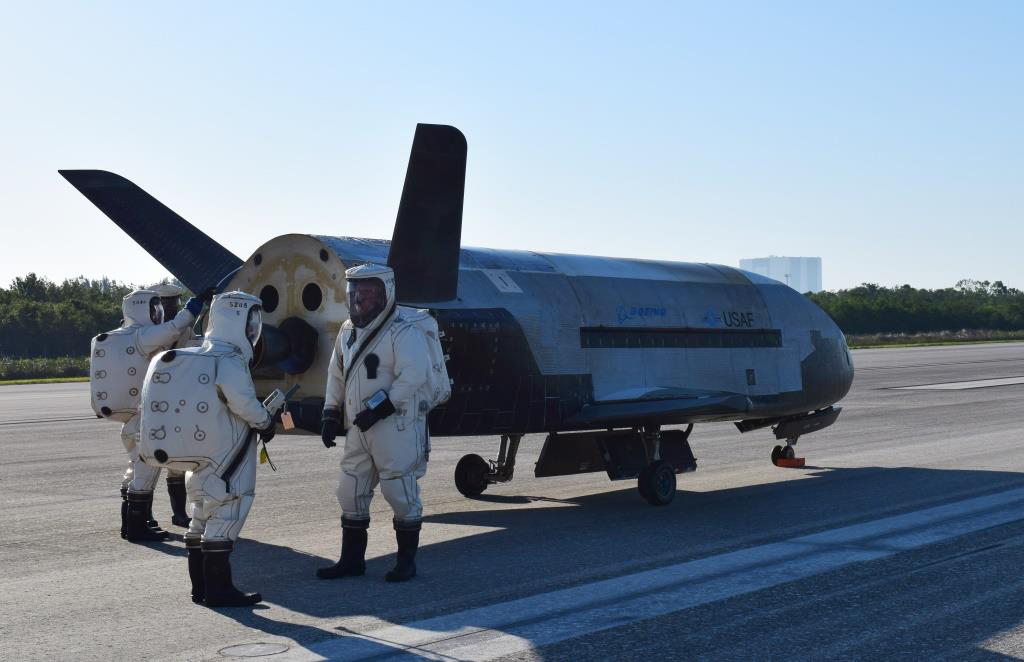Air Force's X-37B Space Plane Lands in Florida After Record-Breaking Secret Mission

The record-shattering mission of the U.S. Air Force's robotic X-37B space plane is finally over.
After circling Earth for an unprecedented 718 days, the X-37B touched down Sunday (May 7) at the Shuttle Landing Facility at NASA's Kennedy Space Center in Florida — the first landing at the SLF since the final space shuttle mission came back to Earth in July 2011. The landing occurred at 7:47 a.m. EDT (1147 GMT).
"Today marks an incredibly exciting day for the 45th Space Wing as we continue to break barriers," Air Force Brig. Gen. Wayne Monteith, the 45th SW commander, said in a statement. "Our team has been preparing for this event for several years, and I am extremely proud to see our hard work and dedication culminate in today's safe and successful landing of the X-37B." [The Mysterious X-37B Space Plane: 6 Surprising Facts]
The just-ended mission, known as OTV-4 (Orbital Test Vehicle-4), was the fourth for the X-37B program. All four launched from Florida's Cape Canaveral Air Force Station, and the first three landed at Vandenberg Air Force Base in California. But Air Force officials have said they want to consolidate X-37B launch and touchdown operations on Florida's Space Coast, so today's landing might be the first of many at the SLF.
"The hard work of the X-37B OTV team and the 45th Space Wing successfully demonstrated the flexibility and resolve necessary to continue the nation's advancement in space," Randy Walden, the director of the Air Force Rapid Capabilities Office, said in the same statement. "The ability to land, refurbish, and launch from the same location further enhances the OTV's ability to rapidly integrate and qualify new space technologies."
The Air Force is known to possess two X-37B space plane vehicles, both of which were built by Boeing. The 29-foot-long (8.8 meters) X-37B looks like NASA's now-retired space shuttle orbiter, only much smaller; indeed, two X-37Bs could fit inside a space shuttle's cavernous payload bay.
The X-37B launches vertically and comes back to Earth horizontally for a runway landing, as the space shuttle did.
Get the Space.com Newsletter
Breaking space news, the latest updates on rocket launches, skywatching events and more!
Most of the X-37B's payloads and activities are classified, leading to some speculation that the space plane could be a weapon of some sort, perhaps a disabler of enemy satellites. But Air Force officials have always strongly refuted that notion, stressing that the vehicle is simply testing technologies on orbit. [The X-37B's Fourth Mystery Mission in Photos]

"Also, the Air Force Research Laboratory (AFRL), Space and Missile Systems Center (SMC), and the Air Force Rapid Capabilities Office (AFRCO) are investigating an experimental propulsion system," she said.
Outside experts generally agree with the Air Force's claims, saying it's unlikely that the X-37B is doing anything aggressive or nefarious on orbit. Some observers have suggested that, in addition to the roles cited by Annicelli, the vehicle may be testing sensors for the National Reconnaissance Office, which operates the United States' fleet of spy satellites.
Each X-37B flight has been longer than the last. OTV-1 lifted off on April 22, 2010, and spent 224 days in space; OTV-2 launched on March 5, 2011, and orbited Earth for 468 days; and OTV-3 began on Dec. 11, 2012, and lasted 674 days. (OTV-4 lifted off on May 20, 2015.)
Though OTV-4 set an X-37B program record, the mission fell far short of the overall mark for longest spaceflight mission. Some Earth-observing satellites have operated for decades, and NASA's twin Voyager 1 and Voyager 2 probes are still sending data home, nearly 40 years after their 1977 launches.
Editor's note: This story was updated Monday, May 8 to include the landing time for X-37B contributed by reporter Irene Klotz.
Follow Mike Wall on Twitter @michaeldwall and Google+. Follow us @Spacedotcom, Facebook or Google+. Originally published on Space.com.
Join our Space Forums to keep talking space on the latest missions, night sky and more! And if you have a news tip, correction or comment, let us know at: community@space.com.

Michael Wall is a Senior Space Writer with Space.com and joined the team in 2010. He primarily covers exoplanets, spaceflight and military space, but has been known to dabble in the space art beat. His book about the search for alien life, "Out There," was published on Nov. 13, 2018. Before becoming a science writer, Michael worked as a herpetologist and wildlife biologist. He has a Ph.D. in evolutionary biology from the University of Sydney, Australia, a bachelor's degree from the University of Arizona, and a graduate certificate in science writing from the University of California, Santa Cruz. To find out what his latest project is, you can follow Michael on Twitter.









